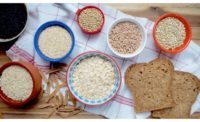In order to dig into current grain trends and some technical wisdom, we reached out to Lin Carson, Ph.D., founder and CEO, BAKERpedia. She is the former director of technical services for Dave’s Killer Bread and R&D manager for Wendy’s International. She also served for several years as a member of the American Society of Baking Board of Directors.
Douglas J. Peckenpaugh: What led you to create BAKERpedia?
Lin Carson: When I was tasked with setting up technical service departments for leading bakery brands a few years ago, I discovered that surprisingly, there was a lack of easily available technical information where baking professionals could refer to and get answers quickly. This drove me to find out more and a few years later, BAKERpedia was born.
DJP: Did your previous professional experiences—at Dave’s Killer Bread and Wendy’s, and running a bakery-café—factor into your decision to focus on BAKERpedia?
LC: Absolutely. These were a necessary part of the journey that led me here. It was experience that motivated me to find answers and a lifelong passion for baking that led to the creation of BAKERpedia.
DJP: What are some of the resources that you offer to the professional baking community via BAKERpedia?
LC: BAKERpedia is an online resource that offers,firstly, free access to credible technical baking science information on ingredients and key processes. You’ll find that all informationis broken down into straightforward answers that avoid unnecessary jargon.
The Academy—a collaboration between industry partners and BAKERpedia—was launched this year offering affordable and comprehensive hands-on, one-day technical classes that are focused on enhancing the skills of any baking professional.
We now have a Technical Services Team who can help with equipment issues and provide quick turnarounds for R&D and quality needs.
DJP: Do you feel like there is a shortage of easily available technical resources for the bakery industry?
LC: Yes. There is definitely a lack of information sharing and regular updates on technology trends in the baking industry. This is the gap that we hope to fill, and we also hope to change mindsets about knowledge share in the industry.
With BAKERpedia, it’s all about getting you all the knowledge and information you need so you can focus on the business of baking and business growth. Ultimately, our mission is to strengthen the baking ecosystem and encourage the baking industry to share knowledge, taking baking to the next level, encouraging ideas to thrive and improving food production worldwide.
DJP: What are some of the technical challenges in gluten-free?
LC: Wheat flour contains 10–14 percent protein. Of these proteins, about 80 percent of them are gluten proteins, which provide the strength and viscosity for the baked product. When you remove all or part of the wheat flour, the function of these important gluten proteins are removed, as well. Non-wheat grain replacement will result in dough with a weak structure that would not hold in the gas produced by yeast or the chemical leavening system. This results in products that are low in volume with a dense crumb grain. Replacing gluten means finding ingredient solutions that cover: 1) Strength—this is done with any other proteins like egg and whey; and 2) Viscosity—this is accomplished by gums or pre-gel starches.
DJP: Which underused grains do you see as holding the best potential for use in new baked goods?
LC: I like sorghum because America produces a lot of sorghum, and it mainly goes into feed. Sorghum contains high levels of diverse and unique phenolic compounds (phenolic acids, flavonoids, anthocyanins, tannins) that are good source of natural antioxidants. My secret wish is for some celebrity chef to pick up this grain, start using it and giveit an unusual,but trendy, name like “Milo.”
DJP: What are some interesting ways bakers can build more better-for-you nutrition into typical baked goods without diminishing the finished food’s customary organoleptic traits and eating quality?
LC: Are you asking me if there is a magical way to make a whole-wheat Krispy Kreme doughnut with less fattaste like the regular Krispy Kreme doughnut? Unfortunately, there are no magical solutions for this. Products sell wellwhen there is a demand for that taste and price. Based on my experience, most substitutions for better nutrition profile have not done well due to the change in taste. The best results I’ve seen from creating better-nutrition products have come from new product launches, not line extensions. So yes, it’s time for bakers to think outside the box when creating products with better nutrition.
DJP: What do you see as some of the top trends in the bakery industry today?
LC: Clean label, whole grains, organic, GMO-free, wheat-free, reduced sodium and sugars, sprouted grains, PHO-free, high protein, sustainability, and social impact.
The trend with the most impact is clean label, and this cannot be ignored, because I see it as a paradigm shift for the baking industry. Clean label technology is eventually going to evolve into artisan bread baking—mainly because many bakers will not be able to keep up their speeds with current clean label technologies. Aninability to keep upwould result in producing more-expensive products. These products can only be sold in the artisan bread category where they would fetch higher prices. As American consumers travel more to Europe, they becomemore receptive to the European-style artisan bread. This would mean that there will be more demand for this type of bread, as compared to a decade ago. This demand, plus the ability to produce artisan bread,would shift the industry from making white pan bread products to artisan bread products. I believe this shift would have the biggest impact on equipment suppliers.
Technical challenges stem mainly from the lack of skilled labor. Skilled labor is a huge issue I see from all the bakeries that I have consulted. Let’s face it, bakeries are not glamorous. From three work shifts to choose from and hardly any weekends off, you’d be lucky if you got two days off in a row. The younger generation has many other options with better pay and better working conditions. That is why the industry is facing a shortage in skilled labor.
What should we do? There has to be an industry-wide effort to achieving a better work-life balance. We need to realize that giving our employees twodays off in a row is not too much to ask for, and recognize that family time is just as important as monetary compensation. We need to push for automation, so that the traditional back-breaking work of lifting flour bags and bread trays are a thing of the past. We need to encourage better food safety and sanitation practices because we want employees to be proud of the food they produce. Bridging the gap with the younger generation means that we need to provide a positive work environment where they would not only be proud of their contributions and achievements,but they would want to share them with their families and friends,as well.





